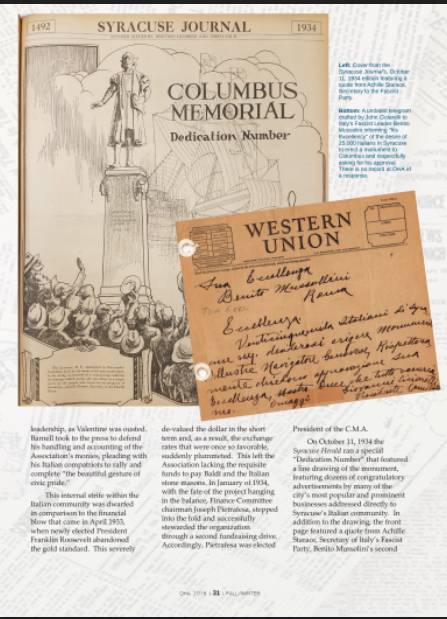
Italian Immigrants and Syracuse History
Loos, J. (March 19, 1897). "Syracuse's Foreign Born Population—Some Statistics". Syracuse Sunday Herald. Syracuse, New York.
Columbus monument in Syracuse
“A Circle of Controversy, Syracuse's Christopher Columbus Monument by Robert Searing”
Robert is the Curator of History at the Onondaga Historical Association
The story begins in 1910, when Syracuse University Professor Torquato DeFelice visited Florence. Prior to his trip, DeFelice and Dr. Serafino Chiarulli, both prominent members of the Italian community, discussed the possibility of raising a monument to the famous Italian mariner in Syracuse, which was home to approximately 7,000 Italians at the time.
About 300 Italian-American women in Syracuse received polished-steel replacement wedding rings on May 25, 1936 after donating theirs to Benito Mussolini. Ignorance does not excuse the giving of funds to Mussolini, but there is no need to vilify unknowing contributors who were subject to propaganda and hoped for a unified Italy. There of course were the privileged-some who were well informed of Mussolini’s dictatorial endeavors and encouraged common people to support facist Italy.
THE SUPPORT OF SYRACUSE’S ITALIAN AMERICANS FOR THE RISE OF FASCISM IN 1930s ITALY AND THE INVASION OF ETHIOPIA
Summary: Mussolini’s fascist endeavors in the 1920s and 1930s are connected to the history of Christopher Columbus’ glorification as a hero in the United States and the placement of a Columbus Statue in Syracuse, NY. History is complex, and unfortunately, this group seems to know as little about this historic period as they do about the 1490s and the onslaught of violence perpetrated by Spanish and European colonialism.
This red paper aims to shed more light on the international sociopolitical context of the 1930s, the rise of fascism in Italy, the brutal 1935 colonial invasion of Ethiopia, and the war crimes committed there by Italian fascist troops. The support of this invasion by Italian Americans from Syracuse is discussed in the context of rising fascism and colonial plunder.
This paper was written by Joseph J. Heath, general legal counsel to the Onondaga Nation and Cayuga Nation traditional leadership. He is currently an adjunct clinic professor at Cornell University. His legal career spans 50 years, beginning with work representing Attica prison inmates.
Photo: 700 North Salina Street, North Salina Street Historic District, Syracuse, NY. Photographed by Crazyale, 2008, [cc0-by-1.0 (creativecommons.org/publicdomain/zero/1.0/deed.en], via Wikimedia Commons, accessed July, 2021)
Little Italy, Then and Now
Italian immigrants first came to the area around Syracuse, New York in 1883 after providing labor for the construction of the West Shore Railroad. At first, they were quite transient and came and went, but eventually settled down on the Northside.
By 1899, the Italian immigrants were living on the Northside of the city in the area centered around Pearl Street.[1] The Italians all but supplanted the Germans in that area of the city and had their own business district along North State and North Salina Streets.
Italian immigrants settled in Syracuse in 1883, after providing the labor for construction of the West Shore Railroad up the Hudson, 150 miles to the east. Some made homes among the Germans in the Northside, though not becoming a real factor in the business community until the second and third decades of the twentieth century.
As early as 1900, Dr. Vincenzo Sarlo had his practice in 921 N. Salina Street, a modest old building at the less fashionable end of the street. Within 15 years the status of the Italians had improved and Domenico Falcone built his "Venetian Restaurant" closer to the heart of the city at 557-59 N. Salina Street. The Mediterranean influence of the design is apparent in the Spanish style pent roof over the second floor windows, behind which still exists an elegant dining room decorated with fancy plasterwork and painted murals of Venice. Falcone and his brothers also operated a bakery up the street at 649 N. Salina Street. The Mediterranean influence is also present in the wrought-iron balcony and tile roof at the second floor level of each of the facades at 537 and 702 N. Salina Street.
The latter was built about 1926 by Antonio Simiele who produced soft-drinks during prohibition in the building next door. Here, full-height French doors opened the first floor dining room to the passers-by and indicates the intent for a sidewalk cafe.
Check out the fabulous places to visit in Little Italy below.
Little Italy in Syracuse | Where to Eat, Shop & Play (visitsyracuse.com)
And what about the Sicilians?
Sicilian immigrants often felt discrimination on the North Side of Syracuse and as a result settled on the West Side of Syracuse with others who faced similar conflict. Their well developed community carried on the traditions that were important to their region of the Italy. Some families still continue businesses and homes that have been in their families for generations.
Italian-American History in the United States
How Italians Became “White” in the US
“Racist dogma about Southern Italians found fertile soil in the United States. As the historian Jennifer Guglielmo writes [outside site], the newcomers encountered waves of books, magazines and newspapers that ‘bombarded Americans with images of Italians as racially suspect.’
They were sometimes shut out of schools, movie houses and labor unions, or consigned to church pews set aside for black people…”
Circle of St. Mary’s and Baptist Church-before the monument
St. Mary’s Church was constructed in 1874 By Lawrence O’Connor. In 1904 Bishop Patrick Ludden selected it to become the new Cathedral. Gardens were tended in front of the Church and then Cathedral and were there until the Columbus Monument was built and installed in this location.




![Photo: 700 North Salina Street, North Salina Street Historic District, Syracuse, NY. Photographed by Crazyale, 2008, [cc0-by-1.0 (creativecommons.org/publicdomain/zero/1.0/deed.en], via Wikimedia Commons, accessed July, 2021)](https://images.squarespace-cdn.com/content/v1/601dbd219c6bdd6741e9df1c/1627246470985-CACKQUZMA1RX79IY3SYF/North+Side.jpg)

